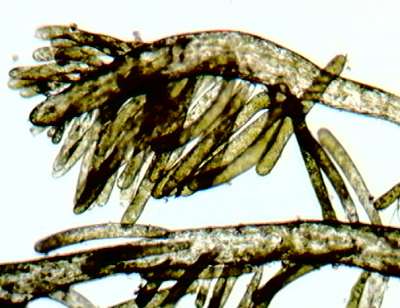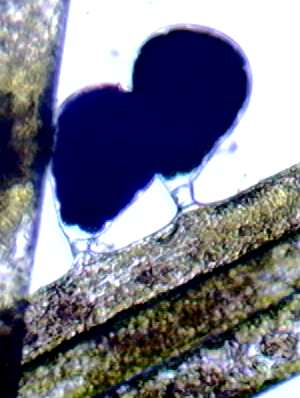Algal food of Placida cremoniana
November 18, 2003
From: Cynthia Trowbridge

PHOTOS: Upper - Bryopsis sp.. Lower - Derbesia showing sporangia.
Dear Bill and colleagues,
I have recently returned from working in Okinawa with Yoshi and Yayoi Hirano and their graduate students. On this visit (Nov 2003) to the west coast of the main island of Okinawa, we were able to clear up numerous mysteries of algal hosts of sacoglossan species. In this message, I describe the diet of Placida cremoniana.
All 3 specimens that we found were on Derbesia which was very common on shady overhangs on shallow subtidal rocky platforms (<1 m). With 10 Bryopsis spp., 2 Derbesia spp., and 2 Pedobesia spp. on Japanese shores, there are many small green algae that could be sacoglossan hosts. In addition to collecting the slugs on Derbesia, we confirmed in lab experiments that Derbesia is actually an algal host (i.e., slugs ate algae, slugs grew, and algae was damaged).
How do you tell these potential algal host genera apart? Bryopsis usually has a main axis with short lateral branches; it looks similar to a feather (see photo). If the alga has no internal cross walls (no cells) and does not branch like a feather, you need to look at the reproductive structures.
On Derbesia, the algal filaments have round to oval structures attached to their surface (see photos). These are the sporangia (spore-bearing structures). If these are present, you need to see if there is there is a basal wall plug present. If it is present (as in these photos), then the alga is Derbesia; if the plug is absent, then you probably have Pedobesia. Many sacoglossans eat Pedobesia lamourouxii (formerly known as Derbesia lamourouxii) so sacoglossan researchers need to find reproductive hosts to confirm the algal genus.
My photos were taken with a portable Olympus Mic-D digital microscope that plugs into a USB port of a computer.
Thanks!
Cordially, Cynthia
trowbric@onid.orst.edu


Thanks Cynthia,
I look forward to hearing more of your work with Yoshi and Yayoi Hirano,
Best wishes
Bill Rudman
Related messages
-
Re: Algal food of Placida cremoniana
From: Cynthia Trowbridge, March 29, 2010 -
Placida cremoniana from the Bay of Biscay
From: Mikel Cortes, April 1, 2008 -
Placida cremoniana from Wollongong, NSW, Australia
From: Sascha Schulz, September 16, 2005 -
Placida cremoniana from Cerbere
From: Marina Poddubetskaia, August 4, 2003 -
Is this a species of Stiliger?
From: Akos Lumnitzer, March 15, 2002 -
Placida cremoniana from Japan
From: Nishina Masayoshi, August 28, 2001 -
Placida cremoniana from Mediterranean
From: Thierry Thibaut, May 12, 2001 -
Placida cremoniana from New South Wales
From: Bill Rudman, May 12, 2001 -
Re: Placida cremoniana
From: Kathe Jensen, May 12, 2001 -
Stiliger cremoniana from SE Sulawesi
From: Lindsay Warren, February 27, 2000
